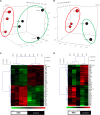Comparison of Glomerular and Podocyte mRNA Profiles in Streptozotocin-Induced Diabetes
- PMID: 26264855
- PMCID: PMC4814194
- DOI: 10.1681/ASN.2015040421
Comparison of Glomerular and Podocyte mRNA Profiles in Streptozotocin-Induced Diabetes
Abstract
Evaluating the mRNA profile of podocytes in the diabetic kidney may indicate genes involved in the pathogenesis of diabetic nephropathy. To determine if the podocyte-specific gene information contained in mRNA profiles of the whole glomerulus of the diabetic kidney accurately reflects gene expression in the isolated podocytes, we crossed Nos3(-/-) IRG mice with podocin-rtTA and TetON-Cre mice for enhanced green fluorescent protein labeling of podocytes before diabetic injury. Diabetes was induced by streptozotocin, and mRNA profiles of isolated glomeruli and sorted podocytes from diabetic and control mice were examined 10 weeks later. Expression of podocyte-specific markers in glomeruli was downregulated in diabetic mice compared with controls. However, expression of these markers was not altered in sorted podocytes from diabetic mice. When mRNA levels of glomeruli were corrected for podocyte number per glomerulus, the differences in podocyte marker expression disappeared. Analysis of the differentially expressed genes in diabetic mice also revealed distinct upregulated pathways in the glomeruli (mitochondrial function, oxidative stress) and in podocytes (actin organization). In conclusion, our data suggest reduced expression of podocyte markers in glomeruli is a secondary effect of reduced podocyte number, thus podocyte-specific gene expression detected in the whole glomerulus may not represent that in podocytes in the diabetic kidney.
Keywords: diabetic nephropathy; gene transcription; glomerulus; podocyte; signaling.
Copyright © 2016 by the American Society of Nephrology.
Figures



References
-
- Steffes MW, Schmidt D, McCrery R, Basgen JM, International Diabetic Nephropathy Study Group : Glomerular cell number in normal subjects and in type 1 diabetic patients. Kidney Int 59: 2104–2113, 2001 - PubMed
-
- Susztak K, Raff AC, Schiffer M, Böttinger EP: Glucose-induced reactive oxygen species cause apoptosis of podocytes and podocyte depletion at the onset of diabetic nephropathy. Diabetes 55: 225–233, 2006 - PubMed
-
- Petermann AT, Pippin J, Krofft R, Blonski M, Griffin S, Durvasula R, Shankland SJ: Viable podocytes detach in experimental diabetic nephropathy: potential mechanism underlying glomerulosclerosis. Nephron, Exp Nephrol 98: e114–e123, 2004 - PubMed
Publication types
MeSH terms
Substances
Grants and funding
LinkOut - more resources
Full Text Sources
Molecular Biology Databases

